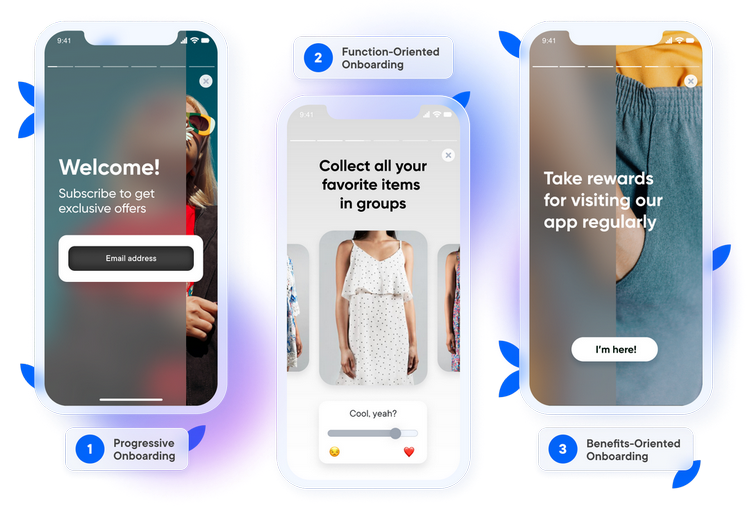
Get inspired by Valentine’s Day campaigns in mobile apps

Challenges in Mobile Onboarding and How to Overcome Them
Mark Polskii
Author @ InAppStory
When users interact with an app or service for the first time, the onboarding experience becomes their initial touchpoint, often dictating whether they'll continue using the platform or abandon it. But what drives a user's perception and behavior during this crucial phase? Delving into the intricacies of psychology can offer invaluable insights. By understanding the cognitive and emotional mechanisms at play, businesses can craft an onboarding journey that not only resonates with users but also encourages them to integrate the app or service into their daily lives. This article explores the essential psychological principles that influence effective user onboarding.
Onboarding Metrics and KPIs: How to Measure Success
The delicate dance of onboarding users is a balance of art and science. But once the strategies are implemented, how do you gauge their effectiveness? After all, a beautifully designed onboarding experience is fruitless if it fails to meet its goals. By focusing on key metrics and KPIs (Key Performance Indicators), businesses can quantify the impact of their onboarding efforts, refine strategies, and work towards delivering a more user-centric experience. This section will guide you through the essential indicators that cast light on the efficacy of your onboarding process.
User Activation Rate
The User Activation Rate is a cornerstone metric in understanding onboarding success. It calculates the percentage of users who undertake a desired action or sequence of actions during or immediately after onboarding, indicating that they perceive value in your app or service.
Benefits of focusing on this metric
Highlighting Value Points: Recognizing actions correlated with long-term user engagement enables businesses to underscore and refine these aspects during onboarding.
Identifying Friction Points: A lower activation rate could signify challenges or ambiguities within the onboarding process that require addressing.
Time to First Value (TTFV)
TTFV is the timeframe for a new user to achieve the first significant value or benefit from your product. Reducing this time means users quickly understand the value of your offering, leading to better retention.
How to improve TTFV?
Streamlined Tutorials: Make initial user guides concise, pointing out core features.
Instant Gratification: Provide users with immediate rewards or benefits upon completing initial actions.
Retention Rates After Onboarding
It's not enough to onboard users successfully; retaining them is where the real challenge lies. Monitoring retention rates after onboarding provides insights into how well the onboarding process prepares users for prolonged engagement.
Steps to optimize post-onboarding retention:
- Re-engagement Tactics: Use push notifications or email reminders to draw users back.
- Continuous Learning: Offer advanced tutorials or feature exploration as users become more comfortable with the app.
User Feedback/Surveys
Direct feedback can be a goldmine of insights. By integrating feedback mechanisms within or post-onboarding, businesses can gain firsthand knowledge of user sentiments, preferences, and pain points.
Effective feedback strategies:
- Open-ended Questions: Encourage users to share their onboarding experience in their own words.
- Rating Scales: Allow users to rate different aspects of the onboarding process, identifying strengths and areas of improvement.
Challenges in Onboarding and How to Overcome Them

Every innovation, regardless of its merits, is met with a natural resistance: the inertia of a potential user who must learn and adapt. Onboarding is the vehicle that ushers users from curiosity to comprehension and, ideally, to commitment. But the road often has bumps and detours. This section shines a light on the common challenges encountered during onboarding and offers actionable strategies to ensure users are not only introduced to but become enamored with your offering.
Personalizing the Onboarding Experience
A generic approach can often lead users to feel out of place. Today’s diverse user base demands a tailored experience that aligns with individual needs and aspirations.
Solutions
- User Segmentation: By classifying users based on criteria like behavior, demographics, or interests, onboarding can be adjusted to cater to specific groups.
- Adaptive Onboarding Flows: Using algorithms or decision trees can help modify the onboarding journey based on user responses or choices.
- Feedback Loops: Encouraging users to provide feedback can reveal insights that drive further personalization and refinement.
Ensuring Clarity and Simplicity
Overwhelming users with too much information or complexity can make them abandon the process altogether.
Strategies
- Minimalist Design: Keep the user interface clean and intuitive. Reduce visual noise.
- Progressive Disclosure: Instead of displaying all the information upfront, reveal it gradually as the user progresses or expresses interest.
- Interactive Tutorials: Instead of static instructions, use interactive demos or walkthroughs to guide users.
Balancing Information with Engagement
While informing users is vital, long-winded explanations can lead to disinterest. Engagement is the key to retention during onboarding.
Tactics
- Gamification: Incorporate game elements, such as points, badges, or levels, to make onboarding more interactive and fun.
- Visual Storytelling: Use animations, graphics, or videos to convey information in an engaging manner.
- Quick Wins: Offer users immediate rewards or benefits after completing initial steps, boosting their motivation.
Overcoming Technical Hurdles
Technical glitches or incompatibility issues can abruptly halt the onboarding process, causing frustration.
Remedies
- Regular Testing: Frequently test the onboarding flow across various devices and platforms to identify and rectify glitches.
- Provide Support Channels: Offer easy-to-access support, be it through chatbots, FAQs, or customer support, to assist users facing technical difficulties.
- Feedback Collection: Allow users to report issues, ensuring continuous improvement.
All in all
Onboarding isn't just a formality - it's an art, a science, and, most importantly, the foundation for a long-term relationship with your users. While we've delved into the nuances of onboarding in this blog, there’s an expansive treasure trove of insights awaiting those truly dedicated to mastering this craft. Enter InAppStory's comprehensive e-book on mobile onboarding, a curated guide for those who aspire to make every user's journey an exceptional one.
Why Dive Deeper?
- Comprehensive Insights: The e-book goes beyond the basics, providing in-depth strategies, real-world examples, and industry-specific guidelines tailored to various audiences.
- Actionable Strategies: Discover tested and proven methods that have transformed the onboarding processes of leading apps worldwide.
- Expert Voices: Learn from industry leaders and onboarding maestros who share their secrets, mistakes, and learnings.
If this blog sparked your curiosity, our e-book will ignite your passion. It’s not just a resource, but a roadmap to creating onboarding experiences that resonate, captivate and convert. Embark on this journey to mastering mobile onboarding, and let every user’s first interaction with your app be the beginning of a lasting relationship.

